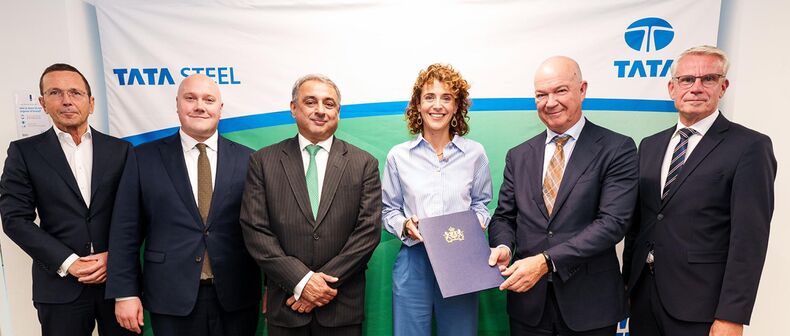Tata Steel signs joint letter of intent with Dutch government and North-Holland
by David Fleschen

Tata Steel and Tata Steel Nederland (TSN) have signed a non-binding Joint Letter of Intent (JLoI) with the Dutch government and the Province of North Holland, outlining a shared ambition to advance the first phase of an integrated project aimed at decarbonising the IJmuiden steelworks and improving public health and environmental quality in the surrounding region.
The JLoI defines the intent and objectives of all parties involved, but does not constitute a legally binding agreement regarding project implementation or the allocation of subsidies. However, it includes a commitment to negotiate in good faith toward a customised binding agreement. These negotiations will continue over the coming months, including the period after the upcoming Dutch elections and the formation of a new government.
Final investment approval will depend on internal processes at Tata Steel and the successful conclusion of the tailored agreement.
Commitment to long-term sustainability
“Tata Steel Nederland is at the beginning of a complex but essential transition,” said T. V. Narendran, CEO and Managing Director of Tata Steel and Chairman of the Supervisory Board of TSN. “We are grateful to Minister Hermans, her colleagues in government, and the provincial team for their constructive work over the past two years to reach this first milestone.
Significant challenges remain. These include finalising technical preparations, resolving regulatory issues related to coking and gas plants, and securing political clarity around key policy questions. We are closely following developments on the EU’s CBAM mechanism and the Dutch CO₂ targets for 2030. Internally, we are working to improve financial performance and competitiveness to secure TSN’s long-term future. The continued support of our trade unions and customers remains essential throughout this transition.”
Decarbonisation and health: key priorities of the first project phase
In the first phase of the project, TSN intends to:
-
Decommission Blast Furnace 7 and Coke & Gas Plant 2, replacing them with a Direct Reduction Plant (DRP) initially powered by natural gas, and an Electric Arc Furnace (EAF) with increased scrap input. This setup could reduce TSN’s Scope 1 CO₂ emissions by 5.4 million tonnes annually, from the current maximum of 12.6 million tonnes.
-
In a second step, implement carbon capture and storage (CCS) for the DRP to achieve an additional 0.6 million tonnes in emissions savings.
-
In a third step, switch to biomethane or hydrogen, when these fuels become economically viable at scale, enabling a further 1.2 million tonnes in annual reductions.
These targets are subject to uncertainty margins and technical feasibility.
Beyond CO₂: Dust, noise, and air quality
TSN also plans to go beyond legal requirements to improve local air quality and reduce nuisance emissions:
-
Cover the pellet plant stockpile and sinter plant blending yard.
-
Enclose ore storage areas and the new slag cooling facility at the EAF.
-
Introduce additional noise, dust, and odour control measures, particularly at slag handling and processing sites.
-
Expand the use of steel slag and increase scrap content in production from 17% (in 2019) to 30%, supporting circular economy goals.
Conditions for a binding agreement
The parties agreed that certain conditions must be met before a final agreement can be signed. These include:
-
For Tata Steel: policy clarity on national CO₂ taxation, electricity grid fees, and the regulatory treatment of steel slag—any of which could impact project viability.
-
For the Dutch government and TSN: proper remediation of legacy environmental liabilities, especially concerning the old coking and gas plants.
Project phasing, total investment volumes, and construction timelines are yet to be finalised, as the technical planning of the integrated transformation is still ongoing.
The Dutch government plans to contribute up to €2 billion in support, while TSN has also applied for €300 million from the EU Innovation Fund. The remaining financing will come from a mix of internal funding, project financing loans, and support from Tata Steel Limited.
Source and Photo: Tata Steel Nederland

